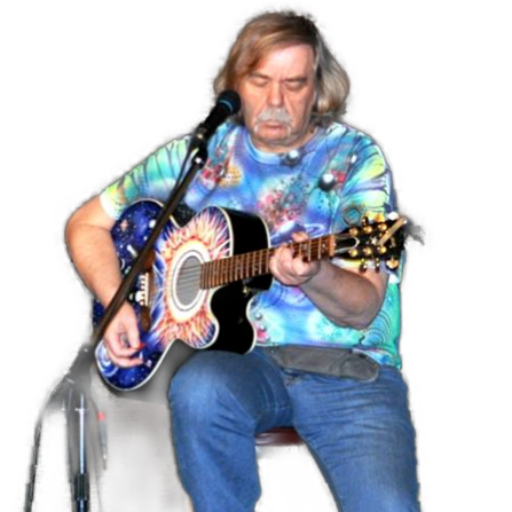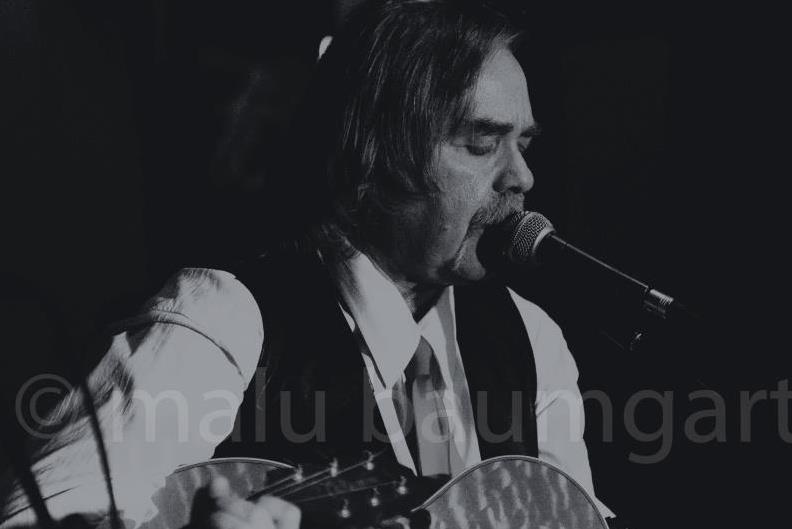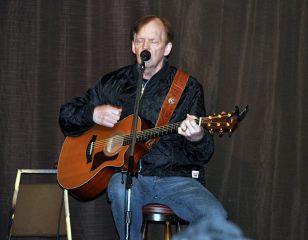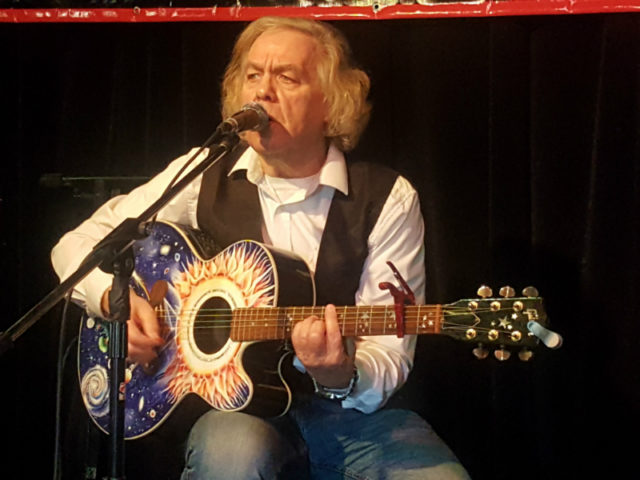Cover Story, Folk Wax Magazine, Sept 2002
By L.H. McLachlan – Just three years ago, Brian Gladstone was an unknown folk artist who had just recorded his first album, Back to the Dirt. Like many indie artists, he had been working in a vacuum, recording his original songs in his home studio. At the time, he didn’t know any other musicians and had no media contacts. It’s a familiar scenario for many indies, who often become overwhelmed and discouraged when they try to break into the professional scene.
But Gladstone isn’t easily discouraged. He believes in creating your own scene-carving out your own unique path to success in the music business.
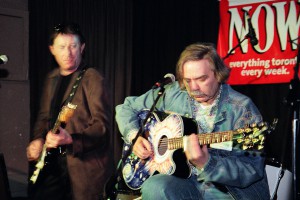
Phingerpicker Extraordinaire
Brian Gladstone
A truly independent artist, who seldom watches TV or reads books or newspapers, Gladstone relies on his own instincts and intuition. He doesn’t spend time worrying about music industry trends and he doesn’t let rejection phase him. Uncommonly persistent and energetic, he’s a man on a mission. “I’m a folksinger who wants to bring the world back to simplicity through fingerpicking,” he says, “that opposing thumb and forefinger concept that separates us from the primates.”
Gladstone spent two years recording Back to the Dirt in a home studio assembled at low cost from music store blowout sales. Well before the album’s release, he invested in a top quality computer, scanner and printer so he could create all of his own promotional materials himself (such as a bio, press kits, posters and mailing cards). He spent a summer learning how to create his website at www.backtothedirt.com and had the site up before the CD launch. He’s a very hands-on guy who at times has been disappointed by others. His graphic designer, for example, delivered the project late and delayed his CD launch.
Often, many DJs would send out play-lists and notices when they’d played Brian’s tunes on their program. He would spend a few hours every night pouring over Internet published play-lists and finding the contact information of radio programs that played acoustic folk music. Gladstone then started to notice that many of the same artists’ names came up repeatedly alongside his in play-lists – DJs were packaging him with similar, but more established artists. He found out who their label was, then contact their labels to let them know that we was getting as much (or more) play as some of their artists; and boldly asked, ‘Why aren’t you talking to me?’ That was a good question. Frank Fara of Comstock records in Arizona talked. After that, Comstock signed Gladstone’s first album, and launched Back to the Dirt in Europe where it quickly got large amounts of airplay.
Gladstone goes on to add, “Many people don’t know how to market their CD. I’ve seen people with hundreds of dusty CDs piled up in their garage. The best thing to do is something. Especially if you know don’t what to do next, just do anything. Make a phone call. Send an email. Book a gig. Make a poster. Much of promotion works on the principle of inertia. A body at rest tends to remain at rest, and it takes a lot of energy to get it moving. However, a body in motion likes to stay in motion and needs little energy to propel itself forward. As soon as you do something, you have generated some momentum and the next move will become more apparent to you. I was always really good at screwing things up – but you learn quickly what works and what doesn’t work. It’s your gig, so you are allowed to make up the rules as you go”
Like all direct marketers, Gladstone gets a modest number of positive responses for his extensive mailings, but every positive response is gold. For example, by randomly sending a promo CD to Guitar 9 magazine, he inadvertently entered a contest and was chosen as “Undiscovered Artist of the Month” – which was accompanied by a great review to turn people onto the tunes. As I result of that incident, he was contacted by HHGI guitar magazine, who also gave a stunning review of the album, and further national exposure. Brian says, “There are always a few people who don’t like your work, there are definitely a majority who do like your work, but there are always a few who love your work. Regardless of anything I’ve tried promo-wise, there are always a few who come back as Mega fans. Your best publicity will always come from people who love your work.” He also credits early airplay on the Worldwide Radio “Rock n Roots” program as the catalyst for more than 150 spins (for “Who Killed Betty Two” and then “Cyberbabe”) on both North American and European radio.
Gladstone reports that even now, after the 2001 release of his second CD Psychedelic Pfolk Psongs, he still spends two or three hours a day on “tracking” his CD sends and following up with music industry contacts. “If you contact radio programmers or press people regularly and are friendly, they may move your CD to the top of the pile. I personally thank all the responses whether it’s a yes or a no. They are all just regular people who appreciate professionalism and sincerity.”
Today Brian has more than 3000 names on his contact list, sorted into categories including friends, clubs, folk festivals, journalists, media, record label and sales outlets. Last year, he sent out 1500 personal Christmas cards, wrote personal notes to anyone who had played his music and even sent small mail-able gifts, such as stickers, he picked up at the dollar store. “I do anything to keep my name in front of people,” he says. “If you don’t make the time to do your own promotion, you’ll have a basement full of CDs in five years.”
In this spirit, he contacted the Earthday Foundation and registered a charity event whereby local musicians would come together each year in a fundraising concert for the environment. Now in its third year, the concert has raised thousands of dollars for the charity and has led to considerable press for Gladstone, including a cover story and photo in TO Nite Magazine-which Gladstone mailed to all of his fans and media contacts.
About getting your name out, Gladstone said, “‘Yes,’ Is the most important word — Whenever someone, anyone, anywhere, any time asks you to play – the answer must always be ‘yes.’ Take every opportunity to get in front of people. You can always tell if they like your tunes – the looks on their faces will always tell.”
“You need a hook – there are lots of talented dedicated performers who will never become recognized,” Gladstone advises. “That’s why it’s so important to understand who likes your tunes, and what is it that they like? Even if the product is music, and driven by creativity, it’s still governed by the rules of marketing and must get someone’s attention before they listen to it. Leave them a legacy – are you selling good feelings? Lyrics? Liberation? Revolution? Peace? Is it your voice, your guitar playing, or perhaps your messages for the betterment of mankind that draw them near to you? Make sure your hook is indelibly etched in their minds.”
Above all, he says, he wants to keep it fun. “When it stops being fun for me, I’ll quit,” he says. So far, the forty-something musician (who also runs a successful high-tech business with his brother) has been able to find enjoyment in many of the things other indie musicians hate: mailing out CDs, making cold calls, even reading negative reviews (of which he’s had a few). Gladstone doesn’t shy away from any negative responses he receives; he’s even spotlighted a few on his website. “The timing is never off,” he comments. “If someone doesn’t like it, there’s a reason, but that’s no reason for me to stop doing what I believe in.”
Lynn McLachlan is a music journalist in Toronto. Printed in September 2002 and again in November 2002
